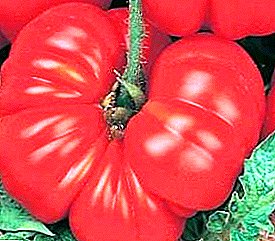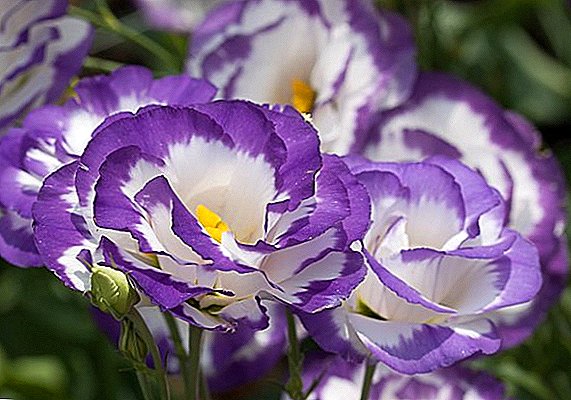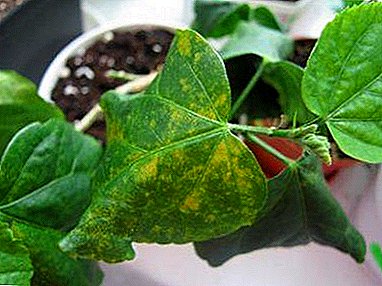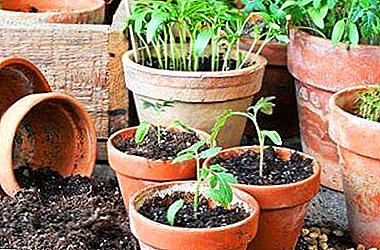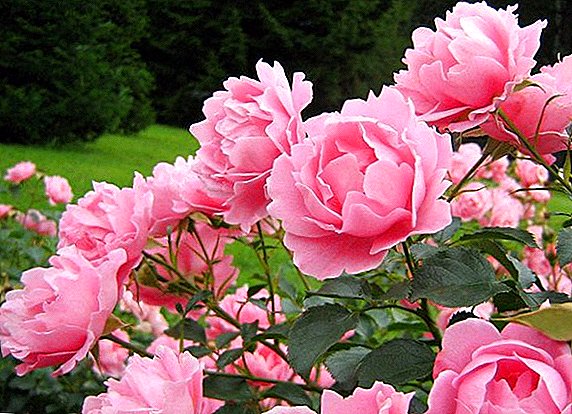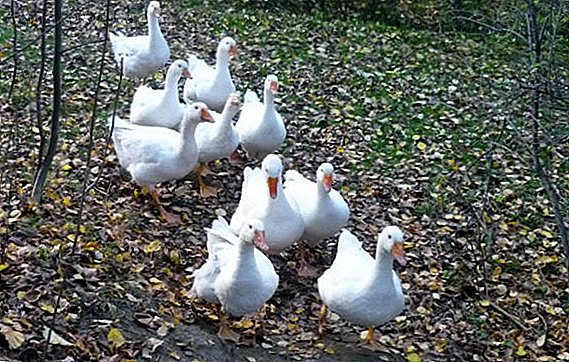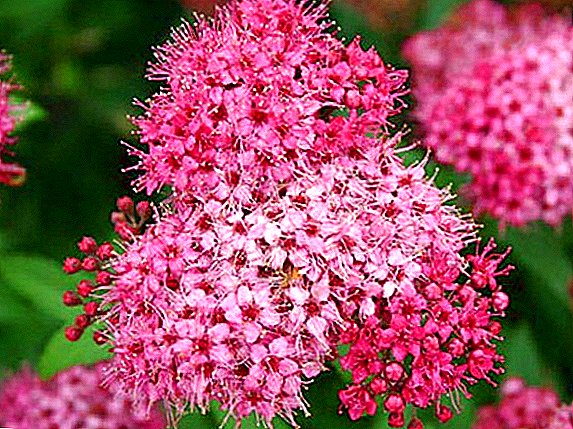 Spirea is a beautiful ornamental shrub that attracts attention with its spectacular color, lush flowering and large bush size.
Spirea is a beautiful ornamental shrub that attracts attention with its spectacular color, lush flowering and large bush size.
Famous for its endurance and unpretentiousness to weather conditions. But in order to be able to fully show himself in all its glory, you need to know some of the subtleties of planting and care.
Spirey Bumald: Japanese hybrid description
Spiraea (meadowsweet) Bomald or pink according to the botanical description belongs to the genus of deciduous ornamental shrubs of the genus pink. Spiraeus Bumalda is a type of Spirey, which has about a hundred. The shrub up to 1 meter has elegant and compact lilac-pink inflorescences. The leaves are colored reddish-green.
Spirea blooms from early June to late September (depending on the climatic zone). Some forms of hybrids have different colors of flowers, ranging from pale pink to white. The international scientific name "spirea" was first introduced by Karl Linnaeus in 1753.
Did you know? The plant is mentioned in the famous epic "Sadko". It describes the use of spirea to determine the draw, which suggests the wide distribution of this method of drawing lots in Russia.
Pink spirea is resistant to severe winter frosts, drought, air pollution in cities. Meadowsweet - plant durable (up to 40 years), honey, not requiring intensive care. 
Spiraeus Bumald distributed not only in Europe. This plant has become a popular decoration for gardens and terraces in Asia and North America. In addition, breeders constantly display new forms of hybrids that are more beautiful and resistant.
If you want to have a whole garden spirey, then you definitely need to know their varieties and varieties.
What loves spirey Bumald, conditions for growing
The plant is not particularly whimsical to the place of planting, but still you should be aware of some subtleties.
How to choose a place for landing (lighting)
To grow a beautiful decorative branch, you need to choose a well-lit area. A partial shade or shadow will not allow the spirea to fully reveal all its decorative qualities. This plant should be planted on the southern side of the site, where there are few trees that will create a shadow.
The plant should receive direct sunlight at least 7 hours a day.. Only then will the inflorescences be able to show all their "pink" beauty.
What should be the soil for planting
Spirea cultivation is best done on a turf or leaf soil. The best proportion of soil composition will be sand, peat and earth - 1: 1: 2. The soil layer should be 0.4-0.5 meters deep. The width of the plot will depend on the number of planted plants.
Meadowsweet can grow without any problems on any other type of soil, but then all the decoration can in a flash fade away. So, if you want to grow the Bumalda spiraeus for decorative purposes, then you will have to slightly change the composition of the soil in your area.
Features planting spiraea Bumalda in the garden
Spiraeus Bumalda or pink needs a proper fit, consider how to grow it in the garden.
How to choose the seedlings Spiraea Bomald
During the purchase of meadowsweet seedlings you need to ask the seller about their ability to breed and winter hardiness. Given these factors, you can control the process of spirea growth.
Important! If you cannot plant them immediately after purchasing the seedlings, they can be left in the refrigerator for 1-2 weeks. In the cold, spireas can persist for a long time.
Many do not know when to buy and plant the Spureea of Bumald. The best time will be the middle or end of April. When buying seedlings, pay attention to the root system of the plant. It must be strong and not damaged by disease.
In addition, the root system must have at least three thick roots and many small hairy roots, which contain clay mass (the clay mass is called the mash, it must be present at the roots when purchased).
Landing pit preparation
Spiraea pink with proper planting and timely care will turn into a lush bush. If the soil is prepared in the manner described above, the holes for planting should be 30% larger than the root system of the plant.
The depth of the pits should reach 40-50 cm. If the soil into which the meadowsweet seedlings are planted is not specially prepared, then the pits should be three times larger than the roots. In this case, the pits are filled with a mixture of sand, peat and leafy earth in a ratio of 1: 1: 2.
Spiraea pink shrub planted in rows. Row spacing should be 35-45 cm. The distance between seedlings in rows should not exceed 50 cm. If the plants are planted very tightly, then they will not be able to grow optimally.
See also what other flowering shrubs can be planted on the site: weigela, heather, hibiscus, hydrangea, chubushnik, magnolia, lilac, camellia, viburnum, silverweed.
Bush planting scheme
Spirea has beautiful pink flowers, which, with proper planting and proper care, will please the eye for decades. Proper planting ensures maximum decorative beauty of the shrub.
Before planting at the bottom of the fossa you need to put a little humus and earth. Then straighten all the roots so that they do not get tangled, and cover the plant with earth. The root neck (the junction of the roots and the trunk) should be located at ground level. It is advisable before planting carefully examine the root system of the seedling and cut off all broken and dried roots. 
If the planting of meadowsweet is made together with the earth on the roots, then after planting the plant must be thoroughly watered with warm water. If the seedling root system is bare, then before planting it must be kept for a day in a growth stimulant solution (succinic acid, "Heteroauxin", indole acetic acid, and others). After a day's exposure, plants can be planted in the holes prepared in advance.
Did you know? In 1839, spiraea began to produce aspirin from shoots. The fact is that in the shoots of this plant there is a glycoside salicin, which as a result of chemical transformations is converted into acetylsalicylic acid (the same aspirin).
It is necessary to take into account the fact that the spiraea of Bumald does not tolerate the increased soil moisture, as a result, its flowering period may not fall into the usual seasonal framework. In places where there is a lot of underground water, the plant may die. Therefore, if you decide to plant a flower in such a place, then you need to know one trick.
Hole for planting need to dig 15-20 cm deeper. First pour gravel or gravel into it, then sprinkle it with a layer of earth, and only then plant groundweed. In this case, groundwater will not flood the roots of the plant. 
Spirey Bumald: care
In order for meadowsweet to flourish splendidly and delight with flowering from year to year, special care is required for it: watering, mulching, fertilizing, pruning, etc.
How to water a charming shrub
When caring for Bumalda spiraea, the soil moisture should be monitored with particular care. This shrub does not tolerate as very dry soil, and very wet.
In the first two weeks after planting, the Meadowstorm should be watered every day (in the evening or in the morning). This will help the root system to get stronger. In the future, you need to monitor the humidity. In very dry periods of summer, the plant should be watered every 4-5 days. 
If the soil around the shrub is treated with mulch (shells from seeds, buckwheat or nuts), then it will keep moisture longer, while the frequency of watering in hot weather will be reduced by 1.5-2 times.
You also need to remember that with frequent watering around the plant weeds begin to grow, which must be weeded periodically. Loosening of the land is carried out in the first hot days after the rains. After loosening the meadowsweet can be a little water.
Plant nutrition and fertilizer
For lush flowering meadowsweet use these types of fertilizers: phosphorus, nitrogenous, potash, etc. 
Fertilize the soil around the bush in two ways.: along with watering or loosening. All important trace elements can be delivered to the root system of meadowsweet along with water.
Fertilizer should be diluted according to the instructions and produce watering, preferably in early spring. It is also possible to fertilize while loosening the soil.
Normal humus will become a good stimulator of growth and flowering. They can simply be mulched, and during the rains all the important trace elements will be absorbed into the soil with water. In the period of drought and before the start of winter, the shrub needs to be fed with superphosphate, for example, Kemira wagon. 
The granular agent is diluted in water and watered the plant according to the instructions.
Features trimming spirea
Spiraea bomald is pruned in spring, but it can also be pruned in summer when it blooms. The gardener usually chooses the haircut form. Krona is made spherical or pyramidal, depending on the style of the garden or terrace. Any pruning does not affect the intensity of growth and development of the shrub.
As a rule, old (10-14 years), weak and dry branches are removed. Some of them need to be cut to stump, depending on what kind of crown you will do. It is best to prune the spring grass until the leaves appear. At this time, you can more accurately form a certain type of crown.
Important! Pruning in the summer leads to the fact that the shrub can re-bloom in the fall. Such manipulations are done in the southern regions of our country, where warm days can last until the end of October.
The main rule of pruning: any shrub older than four years should be formed at a height of 25-30 cm, with the branches and shoots shortened to the first powerful buds.
Reproduction of Spiraea Bomald by cuttings and layering
Propagation of grassland should be in early spring. To do this, it is necessary to make special grooves in which the shoots should be pressed to the ground and attached with small forks. The whole shoot is covered with earth, and its end is cut off.
In winter, the layers are covered with fallen leaves or dried grass beforehand. A year later, by the next spring, the shoot takes root, so it can be cut and planted in a permanent place.
In many Internet forums, beginner gardeners ask how to grow spirea from cuttings. Propagation by this method is one of the easiest and most accessible for any amateur gardener.
Usually, the cuttings begin to harvest after the end of intensive growth of shoots (beginning or middle of June). Pre-cut shoots are planted in containers or special pots, which are filled with peat and river sand.
For proper and normal growth, cuttings need 4-5 times a day (per day). It will be good if you have an installation to create an artificial fog.
Did you know? In Russia, strong rods of spirea were used as whipworm and ramrod.
In most cases, meadowsweet gives a high percentage of survival rate (from 50 to 70%). If, before planting, cuttings are processed in the root growth stimulator, then this percentage can be raised to (90-100%). After rooting cuttings they are transferred to special beds for rearing or planted next spring at a permanent place of growth.
Resistance to diseases and pests
Spirey Bumald after proper planting requires special care (this also applies to the prevention of various diseases). The hybrid of Spiraea Bumald is not so often affected by diseases and pests, but still it happens sometimes. 
The main threat of this shrub is spider mite. After its appearance on the leaves whitish paniculate spots are formed. In the future, the leaves acquire a yellowish tint, then dry and fall. Especially often this pest affects the meadowsweet during dry periods of summer.
Arex (2%), Keltan, Metaphos or Phosphamide are used to fight spider mites. Apply all of the listed drugs according to the instructions for use.
It will be useful for you to know who the spider mite is and how to fight it.
Aphid, which feeds on the juice of shoots and leaves, is considered to be another pest. To combat it, use "Kronefos", "Pirimor" or "Fozalon". Sometimes the meadowsweet is affected by the whitefly. To get rid of this parasite, use "Decis Pro" or "Fitoverm".
Important! Sometimes, albeit very rarely, rain snails can strike a spring. For the prevention of these parasites, you can use the drug "Fitoverm".
In addition to insect pests, shrubs can cause fungal diseases: gray mold and various spots. To combat pathological fungi, fungicide-based preparations are used: Fitosporin-M, Bordeaux liquid, Fundazol, colloidal sulfur and others.
Timely pest control and proper care of the plant will allow the meadowsweeper to fully reveal their decorative qualities.


